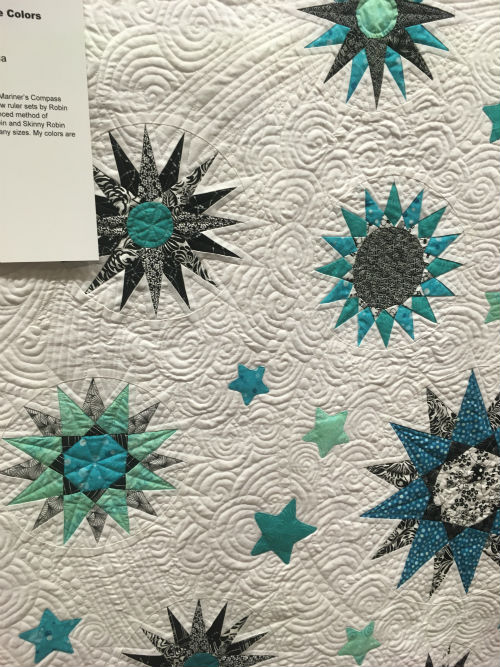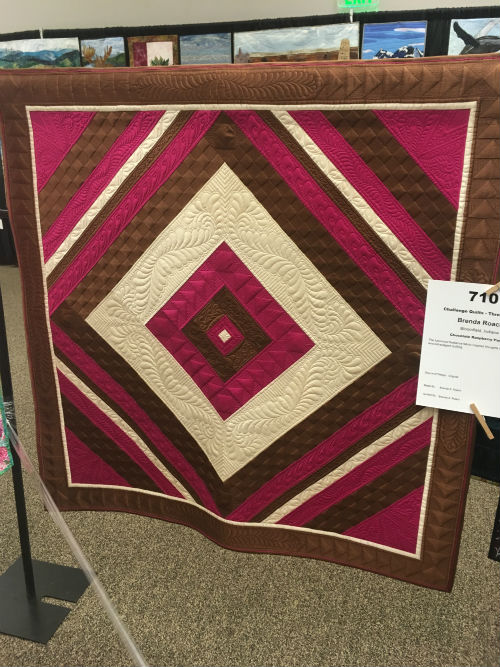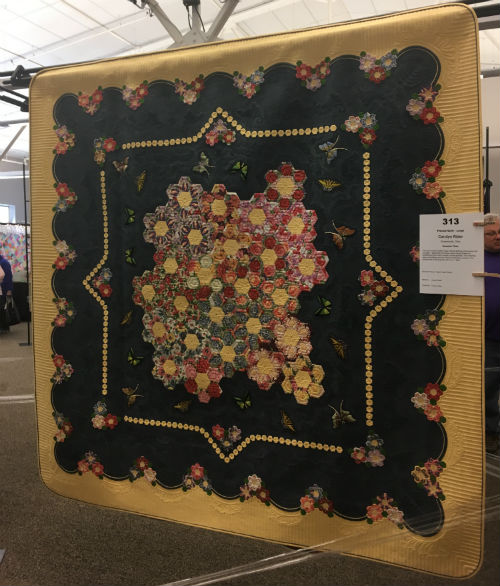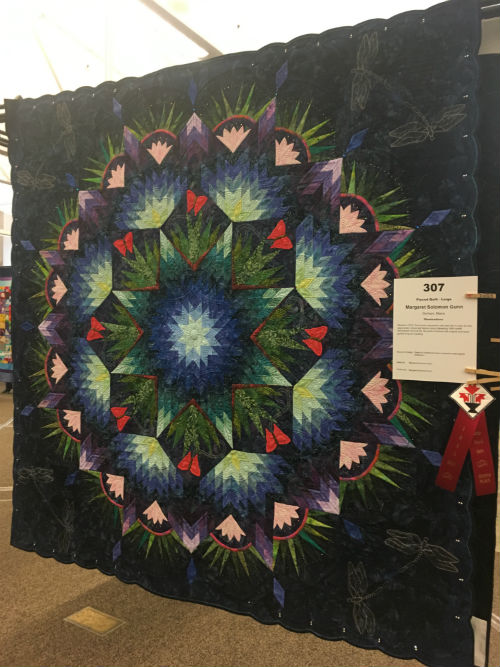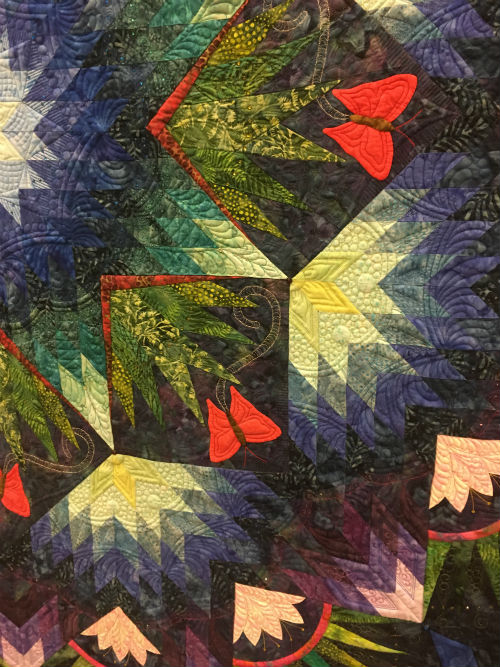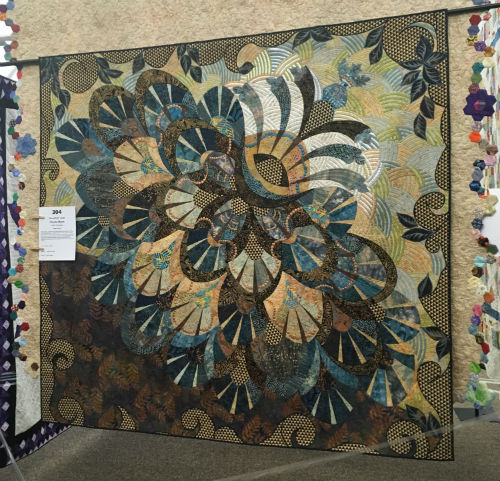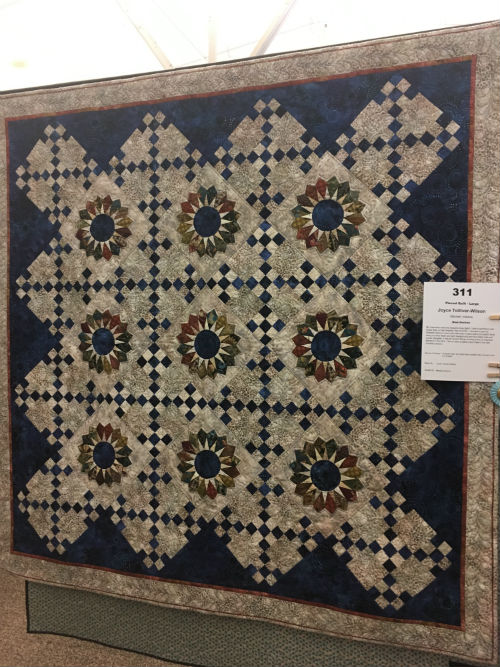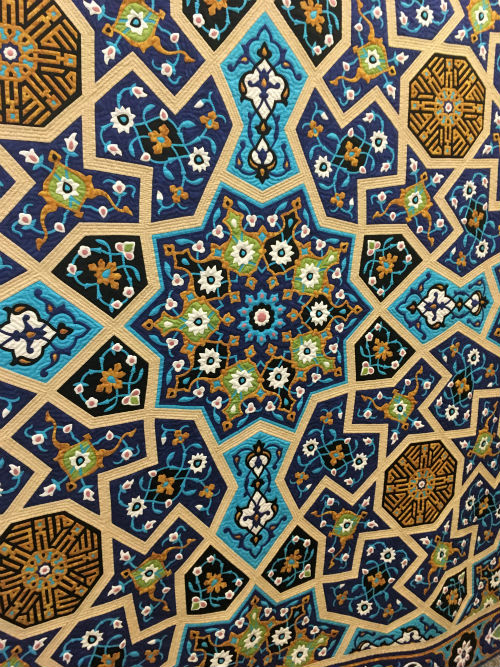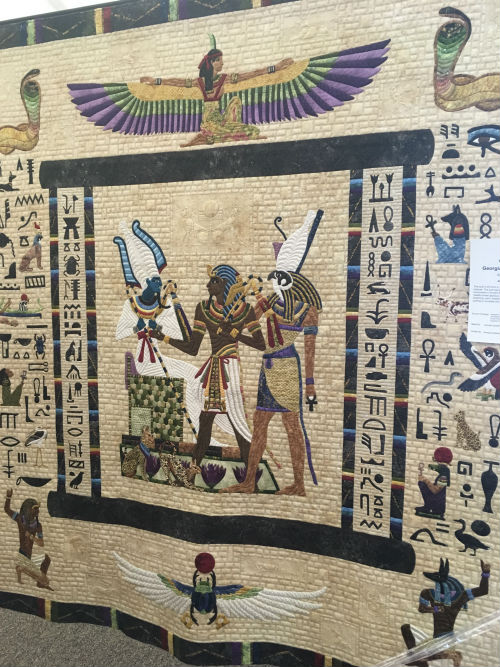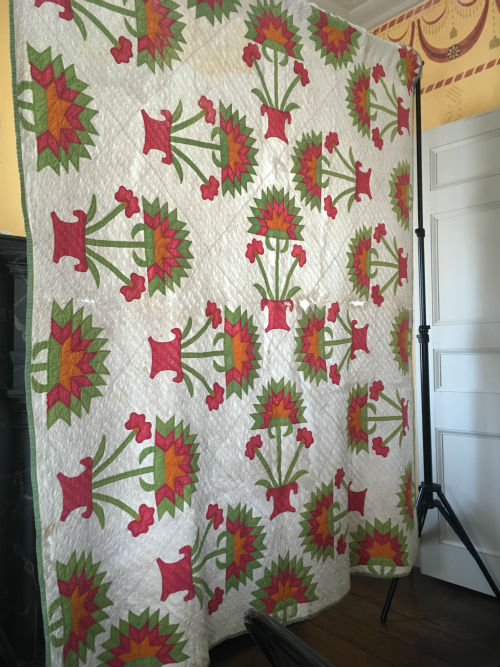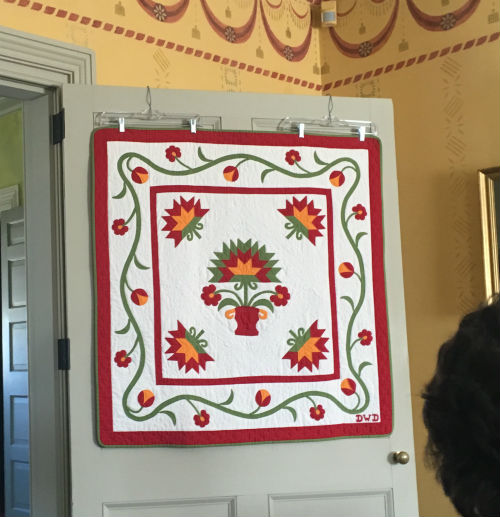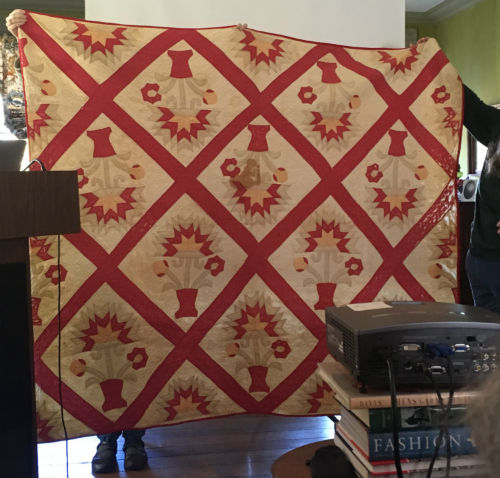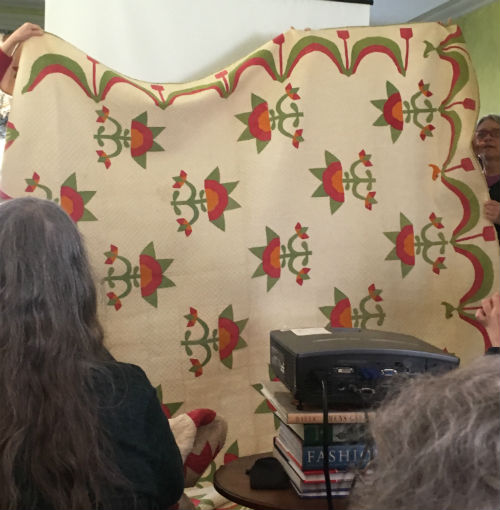Trip to the Indiana Heritage Quilt Show, pt.1
This is one of those posts which I realize has to be done in several parts because it’s going to be very long and include a lot of photographs.
I spent Friday 3/3 and Saturday 3/4 at the Indiana Heritage Quilt Show and related events in Bloomington. It was a wonderful trip and I’m very grateful to the friends who hosted me, since I went down there without anyone. This was my first Quilt Show (I’ve been to auctions, the relief sale, our guild’s quilt show, but nothing like this) and it affected me on a fundamental level. I’ll try to express what I brought home from it. The trip wasn’t just about the show. In fact, it was hearing that Teri Klassen would be speaking about the Polk’s Fancy (see her 2006 article) and what she’d discovered in the decade since its publication that made me decide the drive would be worth it to do both the show and the talk.
I’m dividing this post into 3 parts, how the show changed me, my favorite quilts from the show, and the story of the Polk’s Fancy talk.
How It Changed Me
First, the show brought me greater peace with my own imperfections as a quilter. In the same quilts that awed me, I could look closely and see a minute imperfection that would deeply trouble me if it were in my own quilt. In these quilts? It in no way ruined the effect the quilt had on me as an appreciative audience. I have a long way to come with machine quilting in particular (I’ve used a machine for years, but most of my piecing and quilting is by hand and nearly all my quilting has always been by hand).
I also saw how many quilts were quilted by professionals (including some with minor flaws in the quilting). This doesn’t make me feel superior, but it makes me feel much more at peace with my own work. Unless I work to become one, I can’t compare myself with the professionals. I also see how many quilters also don’t feel up to doing their own quilting. This makes me feel a bit better about the flaws in mine. (I really am extremely harsh on myself, so making sure this transformational moment sticks will be a challenge.)
Second, the talk, compounded by the books I’ve recently been reading, seriously drove home the need for provenance and description in labeling. I have tended to put initials and the year (sometimes just the last two digits) on the quilts I’m making. But last week I decided that wasn’t enough and after the lecture (and the visit to the Mathers Museum which I’ll talk about next) I became deeply convicted. So I’m going to have to do a retroactive labeling project, including mailing needle and thread to people to sew them on.
Third, I am in a continual process of learning to appreciate things which I don’t like. With quilting, with music, with many things, I have an innate sense of the should. I love classical music and power metal because they have many of the same patterns in their notes. Similarly, I love quilts that reinforce a certain kind of pattern sense on my brain. It’s not strict, but it is particular. I’ve been working to develop a sense of appreciating and enjoying choices that people make which I wouldn’t have made—as well as ones I’m not capable of making. A particular challenge for me has been enjoying a quilt when I cannot conceive how I would make it except by a direct copy. The use of organized chaos is very difficult for me to understand. I’ll post a few pics in the part 2 of quilts which challenged me this way.
Favorite Quilts from the Show
(Update 2017-03-06: the IHQS posted pictures and blurbs of the winners here)
Each of these images is linked to a larger version which you may click to view if you want to see more detail. Be warned those images are large and will eat your data if you’re not on wifi.
I saw a lot of quilts and took a lot of pictures but between resizing them and setting them up with alt text and not wanting to overwhelm people, these are the ones that really stood out to me.
“Never Say Never” by Judy Pleiss
Pleiss wrote that she said she’d never make a Mariner’s Compass but then ran across this simplified technique and decided she’d give it a go. I love the result and I’m heartened by the idea of overcoming my own “nevers” (this year I did my first paper piecing, a “never” for me). This was one of the three-color challenge quilts.
“Chocolate Raspberry Parfait” by Brenda Roach
Another three-color challenge quilt. I adored the quilting on this one and the way it’s used to effect texture on the brown. Our guild is doing a challenge quilt this year and I think I may end up doing something similar. Specifically, this inspires me to tackle the medallion style and explore textured quilting for the outliers. Also the colors are similar to the ones I have to work with.
“I’ve Been Framed” by Connie Harris Farrington
I saw the Anne Hutchinson side of this quilt first, but apparently it’s not actually the front. Each block includes a different famous/notorious woman somehow connected to America and convicted of a crime. It includes the truly guilty (shout out to Lavinia Fisher), the tenuous, and the innocent. The Anne Hutchinson side was displayed in the direction I was walking, so I saw it first.
[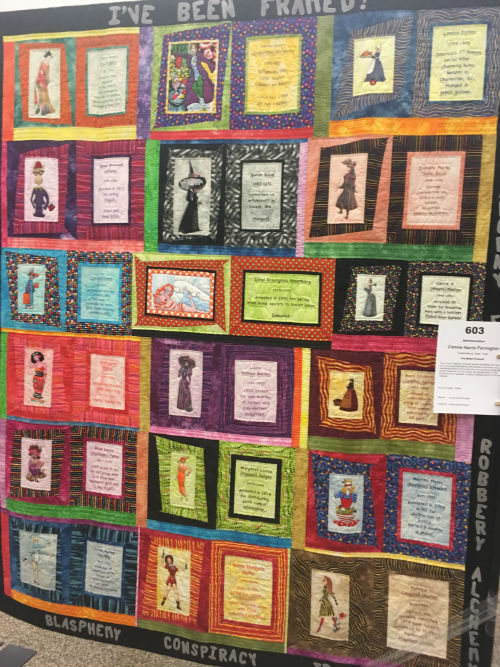 ]
]
(https://ruthtillman.com/ihqs/been_framed_lg.png) 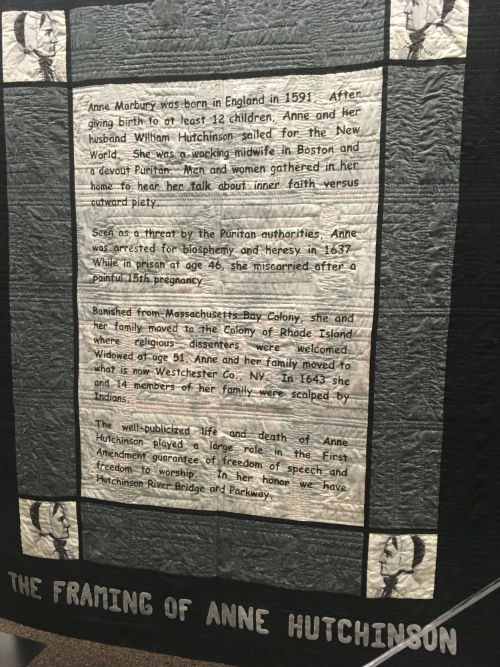
“Summer Time” by Carolyn Rider
I had never seen a flower garden pattern done in a way I could truly enjoy. Some were well-pieced, but it generally feels boring and repetitive to me. The way in which the yellow and the smaller flowers are combined here, along with the use of open blue space and applique, however, were an utter delight. Seeing how it can be integrated into something bigger than just the flower garden inspired me, although I don’t think I’ll be making one any time soon.
“Illuminations” by Margaret Solomon Gunn
This broken carpenter’s star pattern would have been stunning even without the highlights. The use of color here overwhelmed me.
“Night Hawk” by Claudie Myers
I found myself first lost in the curves and patterns before my eyes adjusted to see the whole. Possibly my favorite quilt of the entire show. Stunning.
“Blue Horizon” by Joyce Tolliver-Wilson
Tolliver-Wilson constructed this quilt in order to use the blue batik. I love both the batik and the general pattern.
“Esfahan” by Megan Farkas
As someone who often sees mosaics as quilts, I really appreciated her choice and skill in replicating this one. This is a quilted version of a tile mosaic in the city of Esfahan, using a photograph by Sebastian Giralt for the pattern (with permission).
“Judgment of Osiris” by Georgia Spalding Pierce
Pierce reproduces a tomb painting depicting the Judgment of Osiris here. Unlike the mosaic above, I don’t normally think “quilt!” when I see such a painting, but I’m in awe of how she made it into such a vibrant work.
An Adventure in Polk's Fancy
A brief overview of Polk’s Fancy as we learned about it in Klassen’s talk, combined with the wonder of the talk itself.
Klassen led us on a tale of discovery and research from her own acquisition of a Polk’s Fancy (then an unknown pattern to her):
through finding the one named example, through discovering that this quilt appears to have only been made in a handful of southern Indiana counties during, unsurprisingly, James Polk’s presidency. She follows through learning independently of cousins who created the quilt, through finding the pattern in a book, mis-attributed to the Northeast, and through tracing that photograph back to its owner who confirmed the region as falling within Klassen’s hypothesis. A few key elements of the Fancy which she asserted and backed up through her research:
- The pattern appears to have been made entirely by unmarried young women, mostly teenage girls.
- All but one of the known authors were of German ancestry (Germans do not have the same quilting tradition as some others).
- The quilt appears to have been made not for bed use at first but to show off a girl’s skill with the needle in presenting her as an attractive future wife to in-laws. This kind of work is more common in areas, like these counties, where there is enough relative prosperity to make this feasible.
- These counties are all within short distance of Polk’s riverboat campaign stop in the region.
- The pattern was likely a part of the patriotic spirit also involved in sewing flags and uniforms for local volunteer companies for the Mexican-American war. Indiana had a larger volunteer turnout than expected and the camp where the soldiers assembled was also located in these counties.
- Because this pattern was made by young women and women from a background without quilting tradition, it was likely a fad which was passed around through county fairs and exhibits and then went out of vogue after the war and President were over.
One interesting aspect of the Polk’s Fancy quilts she located and showed us was that, unlike some applique motifs, these did not follow any published pattern of the time and thus had no core standard. The single motif below is a reproduction that captures all the key elements, but every quilt was different:
The audience had a short time to discuss what we saw as similarities in all of the quilts and where we saw variance that still made it not not a Polk’s Fancy (and we’ll see some of that below).
After the talk, Dr. Klassen had expected to see a quilt which someone had discovered and thought might be a Polk’s Fancy, but she and the audience were surprised first by this unexpected woman and her quilt. For me, this was the most beautiful part of my entire Friday. From a pillowcase, an audience member pulled out a quilt she’d picked up for $10 about 40 years ago because, like Dr. Klassen, she was struck by the unusual pattern. Like Dr. Klassen, she’d gone to the historical museum in Salem, IN, and seen the one named Polk’s Fancy on display there. Her quilt was worn and washed out and stained when she got it. The green had faded almost entirely. And yet…it was indeed a Polk’s Fancy. And conceiving the original in my mind’s eye I found it the most beautiful of all the examples, probably because of the bold red sashing between the blocks.
The whole experience had an air of discovery, reunion, of solving a puzzle, of adding to a store of knowledge.
The other quilt brought turned out to be not a Polk’s Fancy or perhaps more accurately a not-Polk’s Fancy. Dr. Klassen believes the fabrics come from the 40s or 50s, but we all agreed that this must have been inspired by an existing Polk’s Fancy. It uses a kind of shorthand to create the flower, although whoever did the quilting didn’t skimp there. The flowers also have no vase, which is another critical part. So the flower piecing was wrong and the vase was missing but this quilt clearly belongs in the family.
There’s more I can write but not more I should write in this one already-long post.
